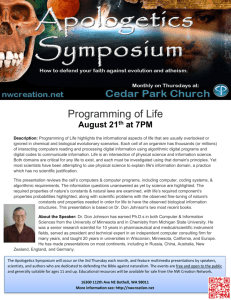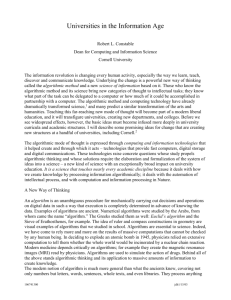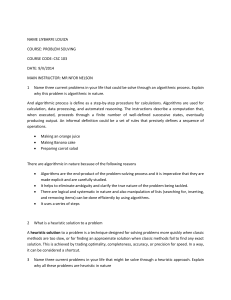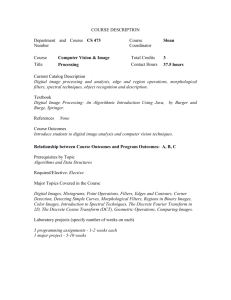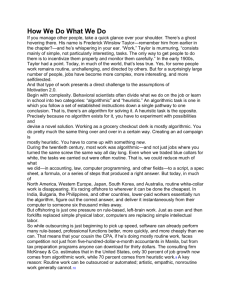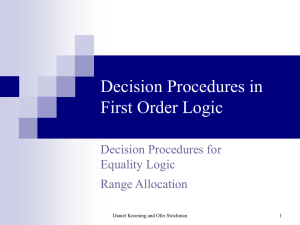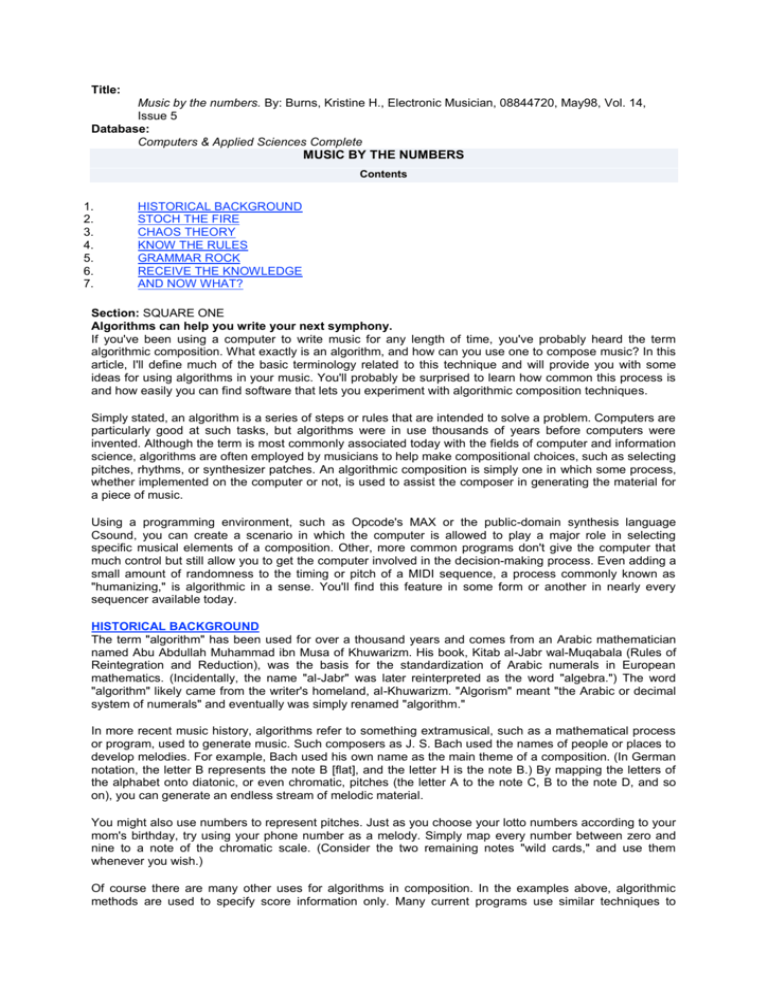
Title:
Music by the numbers. By: Burns, Kristine H., Electronic Musician, 08844720, May98, Vol. 14,
Issue 5
Database:
Computers & Applied Sciences Complete
MUSIC BY THE NUMBERS
Contents
1.
2.
3.
4.
5.
6.
7.
HISTORICAL BACKGROUND
STOCH THE FIRE
CHAOS THEORY
KNOW THE RULES
GRAMMAR ROCK
RECEIVE THE KNOWLEDGE
AND NOW WHAT?
Section: SQUARE ONE
Algorithms can help you write your next symphony.
If you've been using a computer to write music for any length of time, you've probably heard the term
algorithmic composition. What exactly is an algorithm, and how can you use one to compose music? In this
article, I'll define much of the basic terminology related to this technique and will provide you with some
ideas for using algorithms in your music. You'll probably be surprised to learn how common this process is
and how easily you can find software that lets you experiment with algorithmic composition techniques.
Simply stated, an algorithm is a series of steps or rules that are intended to solve a problem. Computers are
particularly good at such tasks, but algorithms were in use thousands of years before computers were
invented. Although the term is most commonly associated today with the fields of computer and information
science, algorithms are often employed by musicians to help make compositional choices, such as selecting
pitches, rhythms, or synthesizer patches. An algorithmic composition is simply one in which some process,
whether implemented on the computer or not, is used to assist the composer in generating the material for
a piece of music.
Using a programming environment, such as Opcode's MAX or the public-domain synthesis language
Csound, you can create a scenario in which the computer is allowed to play a major role in selecting
specific musical elements of a composition. Other, more common programs don't give the computer that
much control but still allow you to get the computer involved in the decision-making process. Even adding a
small amount of randomness to the timing or pitch of a MIDI sequence, a process commonly known as
"humanizing," is algorithmic in a sense. You'll find this feature in some form or another in nearly every
sequencer available today.
HISTORICAL BACKGROUND
The term "algorithm" has been used for over a thousand years and comes from an Arabic mathematician
named Abu Abdullah Muhammad ibn Musa of Khuwarizm. His book, Kitab al-Jabr wal-Muqabala (Rules of
Reintegration and Reduction), was the basis for the standardization of Arabic numerals in European
mathematics. (Incidentally, the name "al-Jabr" was later reinterpreted as the word "algebra.") The word
"algorithm" likely came from the writer's homeland, al-Khuwarizm. "Algorism" meant "the Arabic or decimal
system of numerals" and eventually was simply renamed "algorithm."
In more recent music history, algorithms refer to something extramusical, such as a mathematical process
or program, used to generate music. Such composers as J. S. Bach used the names of people or places to
develop melodies. For example, Bach used his own name as the main theme of a composition. (In German
notation, the letter B represents the note B [flat], and the letter H is the note B.) By mapping the letters of
the alphabet onto diatonic, or even chromatic, pitches (the letter A to the note C, B to the note D, and so
on), you can generate an endless stream of melodic material.
You might also use numbers to represent pitches. Just as you choose your lotto numbers according to your
mom's birthday, try using your phone number as a melody. Simply map every number between zero and
nine to a note of the chromatic scale. (Consider the two remaining notes "wild cards," and use them
whenever you wish.)
Of course there are many other uses for algorithms in composition. In the examples above, algorithmic
methods are used to specify score information only. Many current programs use similar techniques to
generate a score for an instrumental selection, whether acoustic or electronic, that has been predetermined
by the composer. Other programs use algorithmic processes to specify the structure of a composition or
even sound-synthesis parameters. Synoptic's Virtual Waves, for example, uses a process known as cellular
automata to create the spectrum of a sound. Cellular automata is a type of rule-based process, which is one
of the classes of algorithms I'll discuss shortly.
How can a computer make choices, and what are the most common types of processes used for this
purpose? The five essential classes of algorithms used by both scientists and musicians are stochastic
(pronounced "sto-kas-tik"), chaotic, rule-based, grammars, and artificial intelligence. These are all
implemented in different ways and can be used to generate different types of output.
STOCH THE FIRE
Many of the earliest experiments in algorithmic composition were focused around stochastic music and the
related areas of statistics and determinism. Stochastic means controlled randomness and often involves the
use of distribution curves to determine events in a composition (see Fig. 1). Modern composer Iannis
Xenakis first promoted the idea of computer-generated stochastic music in his book Formalized Music,
which was published in 1963 and later translated into English. In certain works, Xenakis used principles of
probability theory to control the overall density of his music. He instructed the computer to generate
thousands of minute "grains" of sound by following certain guidelines.
For example, if the first section of a piece is very dense, using perhaps 100 events per second, the
computer is instructed to limit the number of events in the next section. Then, the computer would calculate
the average density of the previous two sections, add some random number to that average value, and use
the new number to determine the density of the third section. This same procedure could be used to
generate each note's frequency or amplitude or even the lengths of the sections themselves. Obviously, this
technique changes the role of the composer in writing music. Xenakis was well aware of this and in
Formalized Music wrote, "With the aid of electronic computers, the composer becomes a sort of pilot: he
presses the buttons, introduces coordinates, and supervises the controls of a cosmic vessel sailing in the
space of sound."
Though Xenakis has written software for his computer-assisted works, the software is not commercially
available for current desktop computers. However, you can experiment with controlled randomness using
Karl Essl's Real Time Composition Library 3.1 for Opcode's MAX programming language. This powerful
algorithmic system offers numerous distribution curves that can be used to generate many types of musical
material.
You can also try out Andre Bartetzki's Cmask, a system that uses stochastic processes to generate events
for the Csound synthesis language. It offers dozens of "tendency masks" that control the distribution of
events according to the parameters you define. (Cmask works with both the PC and the Macintosh,
although the Web page mentions only the Mac version.)
CHAOS THEORY
The second category of algorithmic process is based on chaos theory. Since the 1970s, the scientific
community has studied the principles behind irregularities in nature, and recently this study has been
applied to musical purposes. One of the most interesting types of chaotic structures is fractals (see Fig. 2).
Fractals were categorized by Benoit Mandelbrot in his book, The Fractal Geometry of Nature. They are
recursive patterns that produce "parent-child" relationships in which the "offspring" replicate the initial
structure. In visual art, you can picture this as smaller and smaller offshoots from the original stem.
Computer-music composers have made use of fractal processes and have often translated data from
scientific applications to musical ones. How would you use this in a composition? One way would be to write
out a series of rhythms and subdivide them into increasingly smaller patterns, all with the same proportions.
Composer Charles Dodge used this approach in a composition titled Profile, and you can hear how he used
fractal patterns in the composition if you listen carefully. You can also experiment with various programs
that use fractals as their basis. At the Fractal Music Project Web page, there's a long list of software that
incorporates fractal and chaos theory.
Lars Kindermann's MusiNum for Windows, for example, generates sequences of binary numbers that it
converts into notes. The sequences are self-similar, meaning that the inner ordering of the numbers
somehow matches the large-scale arrangement of numbers. For example, take this repeating pattern:
0 1 1 0 1 1 0 1 1 0 1 1 0...
Notice that the sequence 0 1 1 0 not only is found as the first four numbers but also is created by taking
every other number:
0 1 1 0 1 1 0 1...
The same pattern can be derived by isolating every fourth number, as well:
0 1 1 0 1 1 0 1 1 0 1 1 0...
Although this simple pattern would sound very repetitive if mapped to MIDI notes, MusiNum allows you to
create far more complex patterns using its Voice Editor function (see Fig. 3). You can even create sixteen
different patterns that run simultaneously!
In addition to software, you'll find an extensive list of references on fractals at the Fractal Music Project
home page. Take at look at the article "Recursion: A Paradigm for Future Music?" by Nicholas Mucherino
for a very thorough discussion of how mathematical properties can be applied to music.
KNOW THE RULES
The third category of algorithmic processes found in music composition programs is incorporated in rulebased, or generate and test, systems. As their name implies, these processes center around a series of
tests and are usually constructed in such a way that the product of one step leads to the next. For example,
the computer might be asked to generate a random note, and if the note falls within a certain range, it is
considered valid and would become part of the composition. But if the note falls outside of the limits set for
the process, it would be discarded, and a new note would be generated.
If you've studied music theory, you've probably had to memorize numerous rules for writing in different
styles. Many composers have designed programs that automatically generate music in certain definable
styles, such as sixteenth-century counterpoint or Bach chorales. Because those types of compositions must
follow constrained rules (e.g., no parallel fifths and octaves, and keep your spacing smaller than an octave
between consecutive voices), rule-based algorithms make perfect sense for modeling them.
The earliest computer-based algorithmic composition was generated from a system of this type. In 1957,
Lejaren Hiller and Leonard Isaacson wrote the "Illiac String Quartet," which is based on rules of sixteenthcentury species counterpoint.
A modern rule-based program is the Automatic Harmonization System (AHS), created by Francois Pachet.
Given a single melodic line, the system will harmonize the melody into a (part setting that respects all the
traditional rules of voice-leading. The user can specify which rules the system should adhere to by selecting
them in a dialog box, and of course, you can define your own rules if you wish to expand the system (see
Fig. 4).
Though AHS is not yet commercially available, you can experiment with rule-based processes using off-theshelf programs like PG Music's Band-in-a-Box. Band-in-a-Box and Soundtrek's The Jammer follow
traditional rules of functional harmony for following chord progressions. You simply tell the program what
style you want, which chords to include, and the desired basic orchestration and instrumentation, and the
software improvises an accompaniment for you. You can also watch for the forthcoming update of
Microworks' Camps, a powerful, "intelligent" sequencer that offers such features as auto-voicing and chord
detection.
GRAMMAR ROCK
The fourth category of algorithmic processes is called a grammar. This category is related to the study of
linguistics, which attempts to identify how human language functions. It examines the components of
language, how they work together as a single unit, and how the components function as single entities
within the larger unit.
One type of grammar, called a formal grammar, is concerned with establishing a hierarchy of relationships
between the whole and its parts. Because music, like language, is made up of small parts that are
combined to make larger entities, this type of process works especially well for composing. To use a
grammar-based process, a composer would start with a seed, which could be a symbol representing a
single note, and progress through a series of generations, in which each symbol is replaced by a string, or
list of symbols.
Imagine that every time you play a note, you add a series of notes to it. For example, for every quarter note
(Q) you start with, you then add the pattern "quarter-eighth" (QE). Here's what you would end up with before
long:
Q
QQE
QQEQQEE
QQEQQEEQQEQQEEE
QQEQQEEQQEQQEEEQQEQQEEQQEQQEEEE
A similar process was used by composer Gary Nelson of the Oberlin Conservatory to compose a piece
called "Summer Song" for solo flute (1991). He employed a method called a Linden-Mayer system, or Lsystem, which in the visual arts is commonly used to create realistic plant structures. Figure 5 shows the
visual equivalent of this grammar and the scale that Nelson derived from it for his piece.
RECEIVE THE KNOWLEDGE
What if a computer could use intuition and logic to create music? With practice, it could "learn" to write
original tunes using artificial intelligence.
Knowledge-based, or Artificial Intelligence (AI), systems are those in which computer algorithms are able to
learn which solutions are acceptable by undertaking a series of comparisons with preexisting material. This
type of programming is often referred to as an "expert system" because it is intended to imitate how a
human expert would handle a problem. The underlying premise is that we learn from our mistakes and
make better choices the next time.
How would you apply this to a musical situation? Let's say you wanted to create a jazz riff generator. Using
an AI process, you could ask the computer to analyze the style of Charlie Parker, examining in particular his
use of intervals, the lengths of phrases, and the contours of his melodies. The system could then use the
analysis data to recreate Parker's style.
A similar approach has been employed by a number of composers, including Charles Ames, Otto Laske,
and David Cope. Cope has done a significant amount of work analyzing the styles of classical composers,
and his Experiments in Musical Intelligence (EMI) system is one of the most fully developed of its type. A
version of the program for the Mac, called Simple Analytic Recombinant Algorithm (SARA), is available at
the composer's Web site, where you'll also find MIDI files produced by the program.
AND NOW WHAT?
You may be surprised to learn that many of the earliest commercial algorithmic programs are still available.
Music Mouse, developed by Laurie Spiegel in 1985, is under active development for the Macintosh. David
Zicarelli's landmark program M was first published by Intelligent Music in 1986 and has recently been
upgraded. It is available from Zicarelli's new company, Cycling 74.
You'll also find algorithmic processes in many current MIDI programs. In addition to the humanizing features
available in most sequencers, very sophisticated algorithmic tools are available in Steinberg Cubase's
Interactive Phrase Synthesizer feature (discussed in "Cubist Art" in the August 1996 EM). Cakewalk Music
Software's Cakewalk offers algorithmic processes through its CAL extensions, and even Coda's Finale
notation program allows you to randomize Note On and Note Off times and Velocity values. There are also
dedicated algorithmic programs on the market, such as SSEYO's Koan Pro, a system used for an entire
album by Brian Eno.
Of course, if you're a real control freak, you can build your own algorithmic processes in Symbolic Sound's
Kyma system, one of the most powerful synthesis workstations around. Its developers have built in
numerous algorithmic "presets," including several of those described here. You might also experiment with
James McCartney's SuperCollider, a powerful software-based programming environment for the Macintosh.
Now that you know a bit more about algorithms and how to apply them in composition, go forth to your
computers and multiply (and add and subtract). Hey, I never met an algorithm I didn't like!
FI
G. 1: Distribution curves are used to control the density of a composition's texture in stochastic music. Here,
a Gaussian curve will generate a large number of events at its midpoint, with fewer events at the beginning
and and of the section it controls.
FIG. 2: Fractals often reflect irregularities
found in nature and can be--useful sources for generating musical material.
FIG.
3:
MusiNum generates self-similar patterns that can be mapped onto MIDI notes. The program allows up to
sixteen note generators to run simultaneously.
PHOTO (COLOR): FIG. 4: The Automatic Harmonization System allows the user to select which rules
should be imposed by the system as it creates an accompaniment part.
PHOTO (COLOR): FIG. 5: An L-system image and the scale derived from it, formulated by composer Gary
Nelson.
ILLUSTRATION
~~~~~~~~
By Kristine H. Burns
Kristine H. Burns is currently the director of the Electronic Music Studios at Florida International University
and the owner and editor of WOW'EM (Women On the Web--ElectronMedia) at
music.dartmouth.edu/~wowem.
Copyright 1998 by Prism Business Media All rights reserved. Copyright of Electronic Musician is the
property of Prism Business Media and its content may not be copied or emailed to multiple sites or posted
to a listserv without the copyright holder's express written permission. However, users may print, download,
or email articles for individual use.


